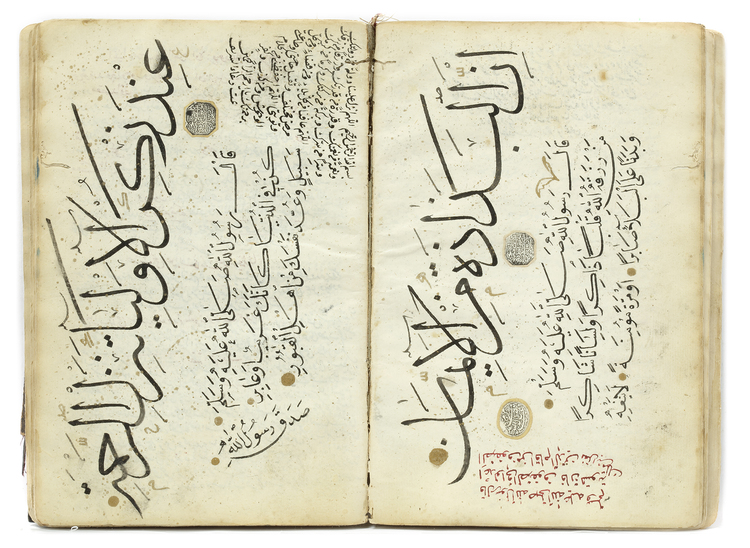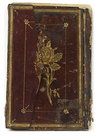AN ANTHOLOGY OF RELIGIOUS AND LITERARY TEXTS, OTTOMAN TURKEY, MID-18TH CENTURY
Arabic and Ottoman Turkish manuscript on European watermarked paper, 91 leaves, various texts (maktubat) written horizontally and diagonally in large and small scripts including naskhi, thuluth, nastaliq and divani in black, red and some gold, some folios detached or loose, discoloration, edges frayed, brown morocco, covers with wild roses painted in gold, inner and outer borders ruled in gold, with flap, of marbled paper, worn, spine damaged. 20 cm by 13 cm.
The wide range of texts includes: the Prophet's letter to the Jinn with an interlinear Turkish translation, numerous prayers, the Qasida (elegy) of Ahmad bin 'Abd al-Razzaq al-Tantarani, prophetic hadith in calligraphic form, pious poems, the Forty Hadith (along with a Turkish translation), excerpts from exegesis of the Quran, copies of letters of famous people (including many of the poet Nabi (d. 1712), described as deceased), witty compositions by Nabi, poems with abjad chronograms marking various occasions such as the births and deaths of high ranking personages, exchanges in the form of poems between the Khan of the Crimea and Sultan Ahmed, a treatise on the Beautiful Names of God, a Turkish translation of a qasida of Sa'di, pious poems explaining how to perform the ritual prayers, biographies of prophets and the imams of the Sunni legal schools, descriptions of Mecca and Medina, explanations of the months, and talismanic material.
The texts are in different hands, but were probably all copied around the middle of the 18th Century. There is a page of seal impressions including many with 18th Century dates, including some ranging between AH 1113/AD 1701-02 and AH 1149/AD 1736-37. One of the hadith is dated AH 1164/AD 1750-1751. The last page has a colophon mentioning the scribe Muhammad, better known as Nazir-zadeh, with the date AH 1124/AD 1712-13. He may be responsible for the leaves, of which there are several, written in large thuluth.







